Contents
Preface
List of Acronyms
1 Introduction
1.1Control System Design Steps
1.2 Adaptive Control
1.2.1 Robust Control
1.2.2 Gain Scheduling
1.2.3 Direct and Indirect Adaptive Control
1.2.4 Model Reference Adaptive Control
1.2.5 Adaptive Pole Placement Control
1.2.6 Design of On-Line Parameter Estimators
1.3 A Brief History
2 Models for Dynamic Systems
2.1 Introduction
2.2 State-Space Models
2.2.1 General Description
2.2.2 Canonical State-Space Forms
2.3 Input/OutputModels
2.3.1 Transfer Functions
2.3.2 Coprime Polynomials
2.4 Plant Parametric Models
2.4.1 Linear Parametric Models
2.4.2 Bilinear Parametric Models
2.5 Problems
3 Stability
3.1 Introduction
3.2 Preliminaries
3.2.1 Norms and Lp Spaces
3.2.2 Properties of Functions
3.2.3 Positive Definite Matrices
Input/Output Stability
3.3.1 Lp Stability
3.3.2 The L2± Norm and I/O Stability
3.3.3 Small Gain Theorem
3.3.4 Bellman-Gronwall Lemma
3.4 Lyapunov Stability
3.4.1 Defnition of Stability
3.4.2 Lyapunov's Direct Method
3.4.3 Lyapunov-Like Functions
3.4.4 Lyapunov's Indirect Method
3.4.5 Stability of Linear Systems
3.5 Positive Real Functions and Stability
3.5.1 Positive Real and Strictly Positive Real Transfer Func-
tions
3.5.2 PR and SPR Transfer Function Matrices
3.6 Stability of LTI Feedback Systems
3.6.1 A General LTI Feedback System
3.6.2 Internal Stability
3.6.3 Sensitivity and Complementary Sensitivity Functions
3.6.4 Internal Model Principle
3.7 Problems
4 On-Line Parameter
Estimation
4.1 Introduction
4.2 Simple Examples
4.2.1 Scalar Example: One Unknown Parameter
4.2.2 First-Order Example: Two Unknowns
4.2.3 Vector Case
4.2.4 Remarks
4.3 Adaptive Laws with Normalization
4.3.1 Scalar Example
4.3.2 First-Order Example
4.3.3 General Plant
4.3.4 SPR-Lyapunov Design Approach
4.3.5 Gradient Method
4.3.6 Least-Squares
4.3.7 Effect of Initial Conditions
4.4 Adaptive Laws with Projection
4.4.1 Gradient Algorithms with Projection
4.4.2 Least-Squares with Projection
4.5 Bilinear Parametric Model
4.5.1 Known Sign of R¤
4.5.2 Sign of ½¤ and Lower Bound ½0 Are Known
4.5.3 Unknown Sign of ½¤
4.6 Hybrid Adaptive Laws
4.7 Summary of Adaptive Laws
4.8 Parameter Convergence Proofs
4.8.1 Useful Lemmas
4.8.2 Proof of Corollary 4.3.1
4.8.3 Proof of Theorem 4.3.2 (iii)
4.8.4 Proof of Theorem 4.3.3 (iv)
4.8.5 Proof of Theorem 4.3.4 (iv)
4.8.6 Proof of Corollary 4.3.2
4.8.7 Proof of Theorem 4.5.1(iii)
4.8.8 Proof of Theorem 4.6.1 (iii)
4.9 Problems
5 Parameter Identifiers and
Adaptive Observers
5.1 Introduction
5.2 Parameter Identifiers
5.2.1 Suffciently Rich Signals
5.2.2 Parameter Identifiers with Full-State Measurements
5.2.3 Parameter Identifiers with Partial-State Measurements
5.3 Adaptive Observers
5.3.1 The Luenberger Observer
5.3.2 The Adaptive Luenberger Observer
5.3.3 Hybrid Adaptive Luenberger Observer
5.4 Adaptive Observer with Auxiliary Input
5.5 Adaptive Observers for Nonminimal Plant
Models
5.5.1 Adaptive Observer Based on Realization 1
5.5.2 Adaptive Observer Based on Realization 2
5.6 Parameter Convergence Proofs
5.6.1 Useful Lemmas
5.6.2 Proof of Theorem 5.2.1
5.6.3 Proof of Theorem 5.2.2
5.6.4 Proof of Theorem 5.2.3
5.6.5 Proof of Theorem 5.2.5
5.7 Problems
6 Model Reference Adaptive
Control
6.1 Introduction
6.2 Simple Direct MRAC Schemes
6.2.1 Scalar Example: Adaptive Regulation
6.2.2 Scalar Example: Adaptive Tracking
6.2.3 Vector Case: Full-State Measurement
6.2.4 Nonlinear Plant
6.3 MRC for SISO Plants
6.3.1 Problem Statement
6.3.2 MRC Schemes: Known Plant Parameters
6.4 Direct MRAC with Unnormalized Adaptive
Laws
6.4.1 Relative Degree n¤ = 1
6.4.2 Relative Degree n¤ = 2
6.4.3 Relative Degree n¤ = 3
6.5 Direct MRAC with Normalized Adaptive
Laws
6.5.1 Example: Adaptive Regulation
6.5.2 Example: Adaptive Tracking
6.5.3 MRAC for SISO Plants
6.5.4 Effect of Initial Conditions
6.6 Indirect MRAC
6.6.1 Scalar Example
6.6.2 Indirect MRAC with Unnormalized Adaptive Laws
6.6.3 Indirect MRAC with Normalized Adaptive Law
6.7 Relaxation of Assumptions in MRAC
6.7.1 Assumption P1: Minimum Phase
6.7.2 Assumption P2: Upper Bound for the Plant Order
6.7.3 Assumption P3: Known Relative Degree n¤
6.7.4 Tunability
6.8 Stability Proofs of MRAC Schemes
6.8.1 Normalizing Properties of Signal mf
6.8.2 Proof of Theorem 6.5.1: Direct MRAC
6.8.3 Proof of Theorem 6.6.2: Indirect MRAC
6.9 Problems
7 Adaptive Pole Placement
Control
7.1 Introduction
7.2 Simple APPC Schemes
7.2.1 Scalar Example: Adaptive Regulation
7.2.2 Modified Indirect Adaptive Regulation
7.2.3 Scalar Example: Adaptive Tracking
7.3 PPC: Known Plant Parameters
7.3.1 Problem Statement
7.3.2 Polynomial Approach
7.3.3 State-Variable Approach
7.3.4 Linear Quadratic Control
7.4 Indirect APPC Schemes
7.4.1 Parametric Model and Adaptive Laws
7.4.2 APPC Scheme: The Polynomial Approach
7.4.3 APPC Schemes: State-Variable Approach
7.4.4 Adaptive Linear Quadratic Control (ALQC)
7.5 Hybrid APPC Schemes
7.6 Stabilizability Issues and Modified APPC
7.6.1 Loss of Stabilizability: A Simple Example
7.6.2 Modified APPC Schemes
7.6.3 Switched-Excitation Approach
7.7 Stability Proofs
7.7.1 Proof of Theorem 7.4.1
7.7.2 Proof of Theorem 7.4.2
7.7.3 Proof of Theorem 7.5.1
7.8 Problems
8 Robust Adaptive Laws
8.1 Introduction
8.2 Plant Uncertainties and Robust Control
8.2.1 Unstructured Uncertainties
8.2.2 Structured Uncertainties: Singular Perturbations
8.2.3 Examples of Uncertainty Representations
8.2.4 Robust Control
8.3 Instability Phenomena in Adaptive Systems
8.3.1 Parameter Drift
8.3.2 High-Gain Instability
8.3.3 Instability Resulting from Fast Adaptation
8.3.4 High-Frequency Instability
8.3.5 Effect of Parameter Variations
8.4 Modifications for Robustness: Simple Examples
8.4.1 Leakage
8.4.2 Parameter Projection
8.4.3 Dead Zone
8.4.4 Dynamic Normalization
8.5 Robust Adaptive Laws
8.5.1 Parametric Models with Modeling Error
8.5.2 SPR-Lyapunov Design Approach with Leakage
8.5.3 Gradient Algorithms with Leakage
8.5.4 Least-Squares with Leakage
8.5.5 Projection
8.5.6 Dead Zone
8.5.7 Bilinear Parametric Model
8.5.8 Hybrid Adaptive Laws
8.5.9 Effect of Initial Conditions
8.6 Summary of Robust Adaptive Laws
8.7 Problems
9 Robust Adaptive Control
Schemes
9.1 Introduction
9.2 Robust Identifiers and Adaptive Observers
9.2.1 Dominantly Rich Signals
9.2.2 Robust Parameter Identifiers
9.2.3 Robust Adaptive Observers
9.3 Robust MRAC
9.3.1 MRC: Known Plant Parameters
9.3.2 Direct MRAC with Unnormalized Adaptive Laws
9.3.3 Direct MRAC with Normalized Adaptive Laws
9.3.4 Robust Indirect MRAC
9.4 Performance Improvement of MRAC
9.4.1 Modified MRAC with Unnormalized Adaptive Laws
9.4.2 Modified MRAC with Normalized Adaptive Laws
9.5 Robust APPC Schemes
9.5.1 PPC: Known Parameters
9.5.2 Robust Adaptive Laws for APPC Schemes
9.5.3 Robust APPC: Polynomial Approach
9.5.4 Robust APPC: State Feedback Law
9.5.5 Robust LQ Adaptive Control
9.6 Adaptive Control of LTV Plants
9.7 Adaptive Control for Multivariable Plants
9.7.1 Decentralized Adaptive Control
9.7.2 The Command Generator Tracker Approach
9.7.3 Multivariable MRAC
9.8 Stability Proofs of Robust MRAC Schemes
9.8.1 Properties of Fictitious Normalizing Signal
9.8.2 Proof of Theorem 9.3.2
9.9 Stability Proofs of Robust APPC Schemes
9.9.1 Proof of Theorem 9.5.2
9.9.2 Proof of Theorem 9.5.3
9.10 Problems
Appendix
A Swapping Lemmas
B Optimization Techniques
B.1 Notation and Mathematical Background
B.2 The Method of Steepest Descent (Gradient Method)
B.3 Newton's Method
B.4 Gradient Projection Method
B.5 Example
Bibliography
Index

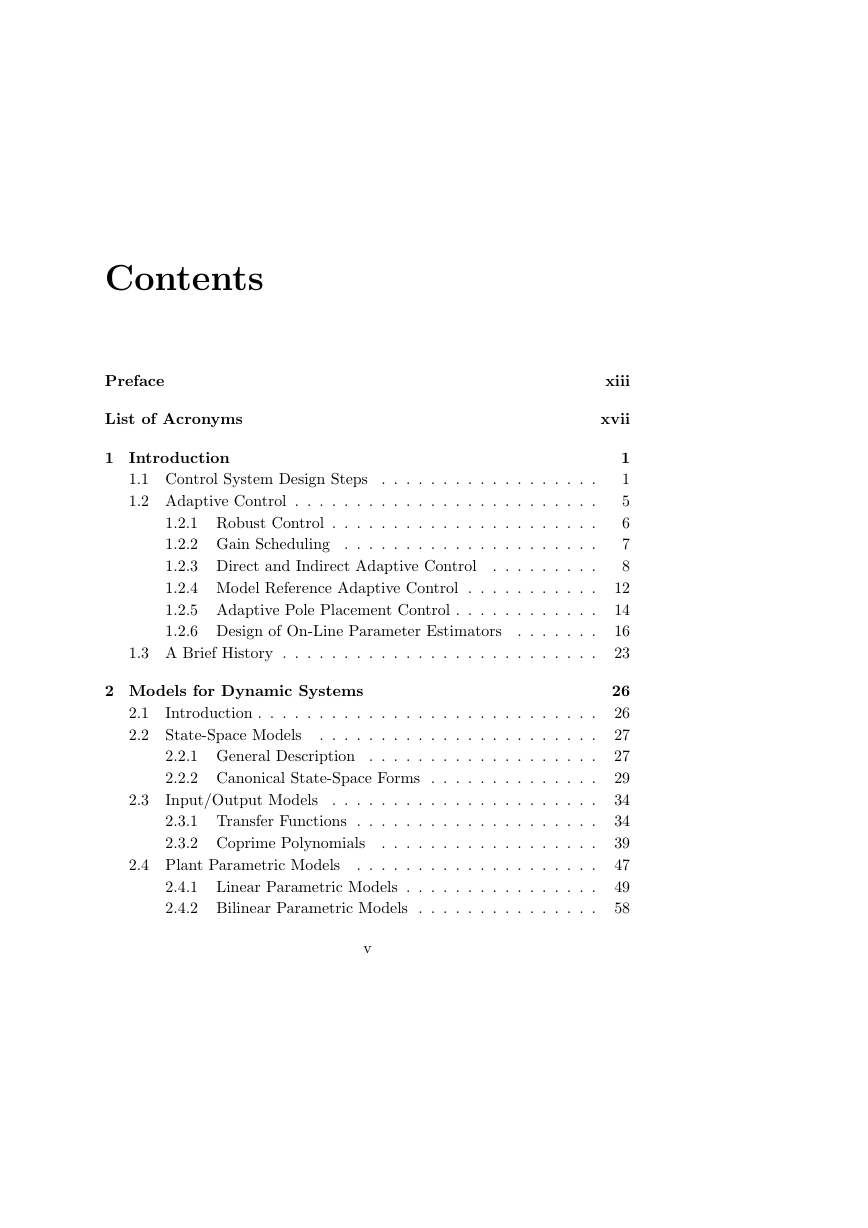

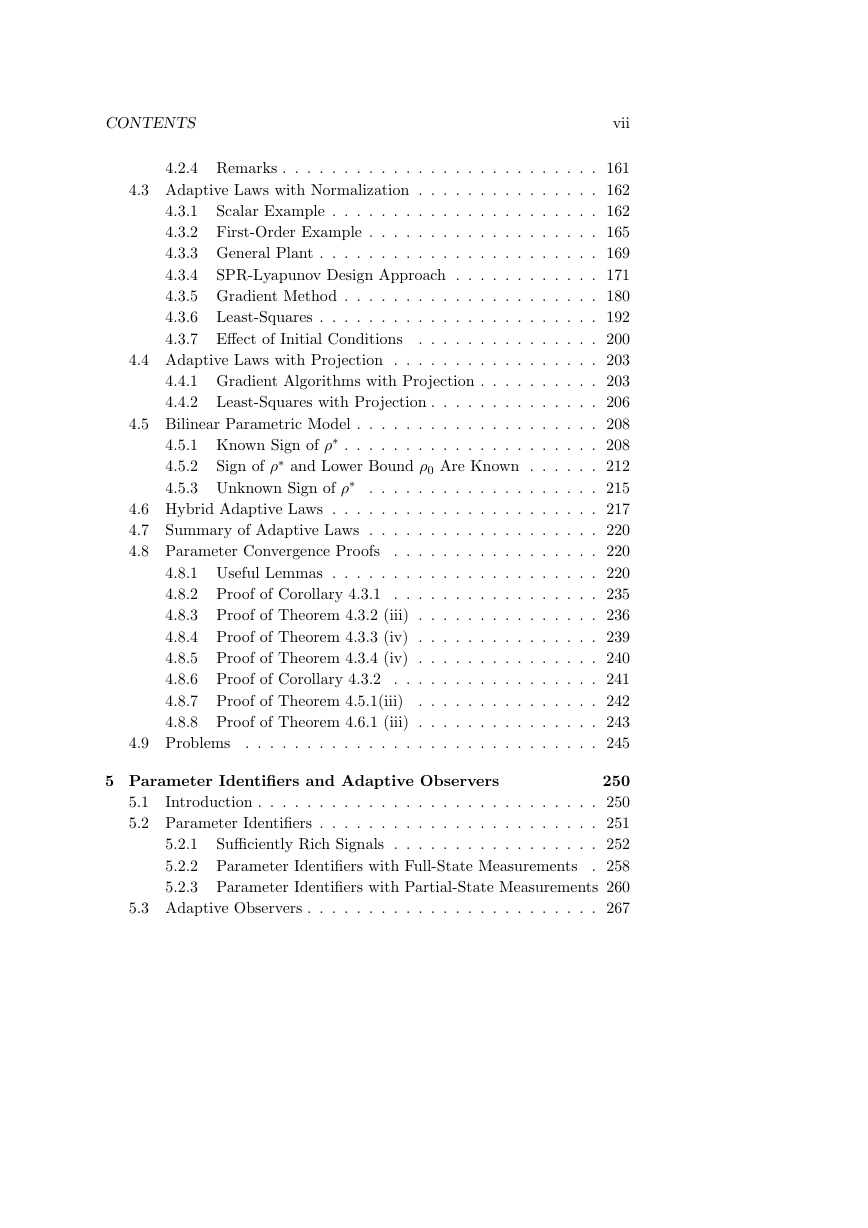
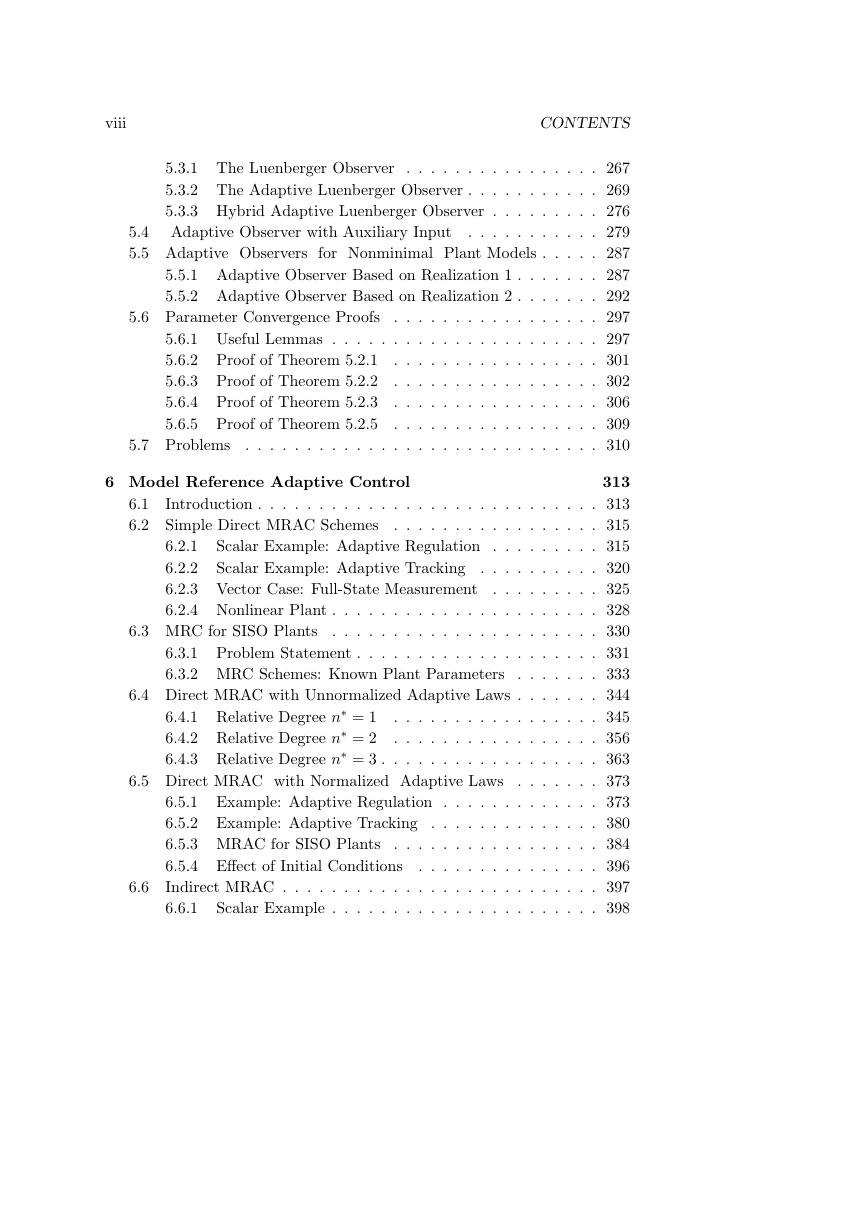
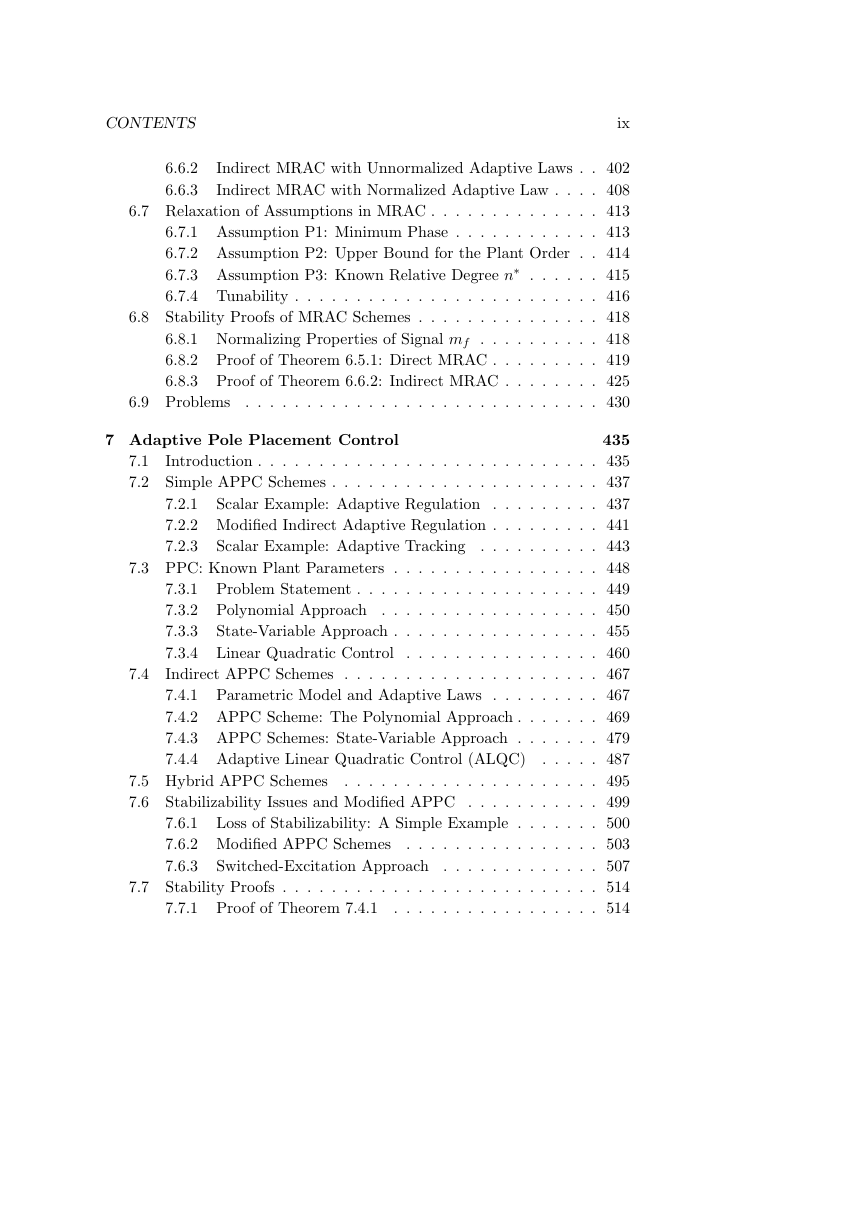

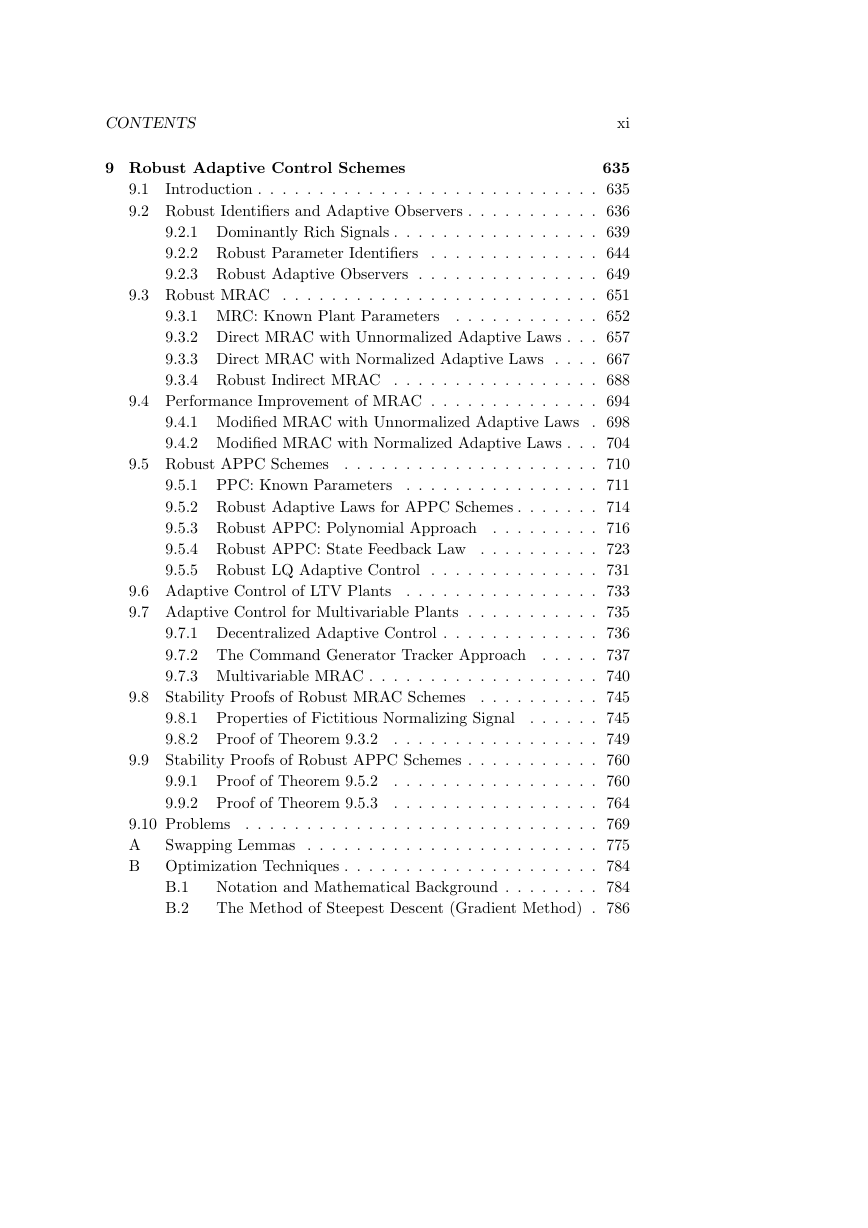








 2023年江西萍乡中考道德与法治真题及答案.doc
2023年江西萍乡中考道德与法治真题及答案.doc 2012年重庆南川中考生物真题及答案.doc
2012年重庆南川中考生物真题及答案.doc 2013年江西师范大学地理学综合及文艺理论基础考研真题.doc
2013年江西师范大学地理学综合及文艺理论基础考研真题.doc 2020年四川甘孜小升初语文真题及答案I卷.doc
2020年四川甘孜小升初语文真题及答案I卷.doc 2020年注册岩土工程师专业基础考试真题及答案.doc
2020年注册岩土工程师专业基础考试真题及答案.doc 2023-2024学年福建省厦门市九年级上学期数学月考试题及答案.doc
2023-2024学年福建省厦门市九年级上学期数学月考试题及答案.doc 2021-2022学年辽宁省沈阳市大东区九年级上学期语文期末试题及答案.doc
2021-2022学年辽宁省沈阳市大东区九年级上学期语文期末试题及答案.doc 2022-2023学年北京东城区初三第一学期物理期末试卷及答案.doc
2022-2023学年北京东城区初三第一学期物理期末试卷及答案.doc 2018上半年江西教师资格初中地理学科知识与教学能力真题及答案.doc
2018上半年江西教师资格初中地理学科知识与教学能力真题及答案.doc 2012年河北国家公务员申论考试真题及答案-省级.doc
2012年河北国家公务员申论考试真题及答案-省级.doc 2020-2021学年江苏省扬州市江都区邵樊片九年级上学期数学第一次质量检测试题及答案.doc
2020-2021学年江苏省扬州市江都区邵樊片九年级上学期数学第一次质量检测试题及答案.doc 2022下半年黑龙江教师资格证中学综合素质真题及答案.doc
2022下半年黑龙江教师资格证中学综合素质真题及答案.doc